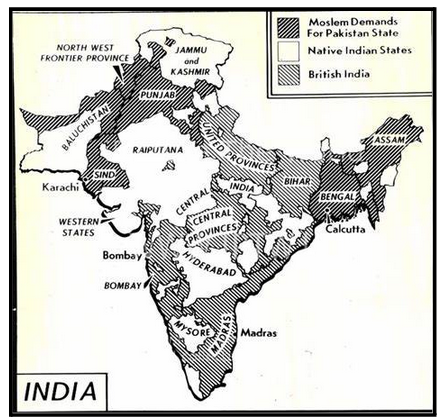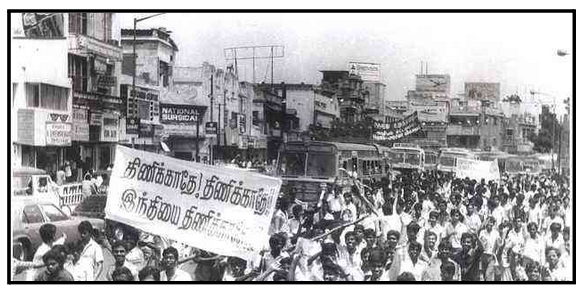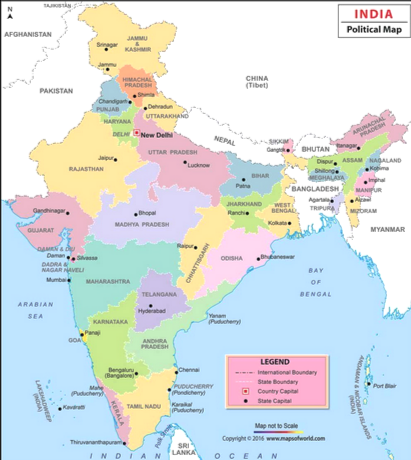GS1- History
Introduction: India's rich cultural tapestry is woven from a multitude of languages, each with its unique alphabet, grammar, vocabulary, and literary traditions.
The concept of reorganizing states based on linguistic regions began taking shape in the early 1900s, setting the stage for a transformative journey in post-independence India. In this exploration, we will delve into the conceptual development of state reorganization, the challenges faced during this process, and the critical elements that contributed to shaping the modern political map of India.
Before Independence

Before India's independence in 1947, the country boasted a rich socio-linguistic landscape, characterized by a multitude of languages, each carrying its own cultural and historical significance. This diverse tapestry of languages and dialects formed the backbone of India's unique and intricate linguistic diversity. Here's a concise summary of the socio-linguistic status of Indian states and provinces before 1947:
- Hindi Heartland: The northern region of India was primarily dominated by Hindi-speaking populations. States like Uttar Pradesh, Bihar, Madhya Pradesh, and Rajasthan had a significant presence of Hindi speakers. Hindi was, and still is, one of the most widely spoken languages in India, with millions of speakers.
- Dravidian South: In the southern part of India, Dravidian languages were prevalent. Tamil, Telugu, Kannada, and Malayalam were the major languages spoken in states like Tamil Nadu, Andhra Pradesh, Karnataka, and Kerala, respectively. These Dravidian languages are among the oldest in the world, with rich literary traditions and a vast number of speakers.
- Bengali Dominance: West Bengal was the primary state where Bengali was the dominant language. Bengali is one of the most spoken languages globally and has a significant cultural and literary heritage. It boasts over 230 million speakers.
- Punjabi and Gujarati Regions: Punjab and Gujarat were characterized by the dominance of Punjabi and Gujarati, respectively. Punjabi is a language spoken by over 100 million people, and Gujarati has around 55 million speakers. Both languages have unique scripts and vibrant cultural identities.
- Marathi Influence: The state of Maharashtra had Marathi as its primary language. Marathi, with over 83 million speakers, has a long history and a strong literary tradition.
- Northeast Diversity: The northeastern states of India were home to a plethora of languages. Assamese, Manipuri, Bodo, and other indigenous languages were spoken in this region. The northeast alone is home to more than 220 languages.
- Kashmiri in the North: In Jammu and Kashmir, Kashmiri was the dominant language, with its own unique script. Kashmiri is spoken by around 7 million people.
- Sanskrit and Classical Languages: Classical languages like Sanskrit were revered and used for religious and scholarly purposes. Sanskrit served as the root language for many modern Indian languages and has thousands of years of history.
- Linguistic Diversity: India's socio-linguistic status was marked by incredible diversity. It was a land of many languages, dialects, and scripts, each contributing to the rich cultural tapestry of the nation. India is home to thousands of languages, making it one of the most linguistically diverse countries in the world.
Before independence, these linguistic diversities coexisted and contributed to India's unique cultural mosaic. It was after independence that linguistic reorganization became a prominent issue, leading to the formation of states based on linguistic lines in the subsequent years. This reorganization was driven by a need for more efficient governance, administration, and a desire to respect linguistic identities.
An Idea Taking Shape
The seeds of state reorganization were sown with the formation of provincial Congress Committees based on linguistic zones following the Indian National Congress's (INC) Nagpur Session in 1920. Visionaries like Lokmanya Tilak and Mahatma Gandhi supported and advocated linguistic restructuring. However, after partition, Prime Minister Nehru was cautious about further dividing the nation along linguistic lines.
Linguistic Province Commission
The Constituent Assembly established the Linguistic Provinces Commission in 1948, led by Justice S.K. Dhar, to investigate the desirability of linguistic provinces. The commission examined the cases of Andhra Pradesh, Karnataka, Kerala, and Maharashtra. Initially, the Dhar Commission expressed reservations, fearing that linguistic reorganization might jeopardize national unity and pose administrative challenges. This led to the formation of a committee, known as the JVP committee, with leaders like Nehru, Sardar Patel, and Pattabhi Sitaramayya, to reconsider the issue.
Language-Based Movements
In the late 1940s and early 1950s, linguistic independence movements resurged. Notable among them were the Samyukta Maharashtra and Maha Gujarat movements, aimed at uniting Kannada-speaking populations from Madras, Mysore, Bombay, and Hyderabad. These movements persisted, despite initial setbacks, and continued to gather momentum.
Formation of Andhra State

The demand for linguistic states found a passionate advocate in Potti Sriramulu, a prominent freedom fighter. He embarked on a fast in 1952, ultimately giving his life for the cause of a separate Andhra state. His sacrifice ignited widespread protests, leading to the Vishalandhra movement. On December 19, 1952, Prime Minister Nehru announced the formation of Andhra State, marking a significant milestone in the linguistic reorganization of India.
Formation of State Reorganisation Committee
The creation of Andhra Pradesh triggered demands for linguistic states in various regions of India. In response, in August 1953, Nehru established the States Reorganisation Commission (SRC) to objectively and dispassionately examine the restructuring of states based on linguistic principles. The SRC, led by Justice Fazl Ali, K.M. Panikkar, and Hridaynath Kunzru, recognized the linguistic principle and recommended redrawing state boundaries. These recommendations were approved, leading to the States Reorganisation Act of 1956, which came into effect in November 1956, creating 14 states and six centrally administered areas. Notably, the SRC opposed the division of Bombay and Punjab, sparking significant unrest in Maharashtra.
The linguistic reorganization of India was a significant achievement after over a decade of relentless struggles and public movements. However, India's evolving landscape saw the emergence of new developments.
Formation of Sikkim
Sikkim, a "Protectorate" of India, initially had a unique status, neither fully sovereign nor entirely independent. Dissatisfaction with this arrangement led to a democratic movement, with the Lepcha-Bhutia community advocating for closer ties with India. In 1975, Sikkim formally merged with India after an assembly resolution and a subsequent referendum.
Liberation of Goa
Goa, Daman, and Diu were under Portuguese rule for centuries, marked by misgovernance, religious conversion, and repression. In 1961, Indian forces, as part of Operation Vijay, ended Portuguese rule, and Goa was admitted as a state in the Indian Union in 1987.

Reorganization of States in Modern Times
In modern times, further state formation occurred in response to demands based on various factors, including ethnic identity, developmental needs, and administrative challenges.
- Uttarakhand: In 2000, Uttar Pradesh was divided, leading to the creation of Uttarakhand, India's 27th state. This move addressed the developmental disparities and unique geographical challenges of the region.
- Jharkhand: Born out of the tribal region of Bihar, Jharkhand became India's 28th state in 2000. The tribal communities of the region sought autonomy and improved development, resulting in their long-standing demand for a separate state.
- Telangana: Telangana, a region with its distinct identity, became India's 29th state in 2014, following a prolonged struggle for statehood.
Present State Border Issues in India
The journey of state reorganization in India continues to evolve, marked by ongoing border disputes and regional aspirations. Some of the prominent state border issues include:
- Kashmir: The conflict over the region of Jammu and Kashmir, with India, Pakistan, and China holding claims over various parts, remains a complex issue.
- Assam-Nagaland Border: The Assam-Nagaland border dispute has led to violent clashes and territorial conflicts over the years.
- Meghalaya-Assam Border: Meghalaya and Assam have border disputes, primarily concerning the demarcation of boundaries, leading to tensions between the states.
- Karnataka-Tamil Nadu Water Dispute: The sharing of Cauvery River water between Karnataka and Tamil Nadu has resulted in prolonged disputes and legal battles.
- Sikkim-Darjeeling Disputes: Sikkim has ongoing border issues with Darjeeling and West Bengal, primarily related to territorial claims.
- Gorkhaland Movement: The demand for a separate Gorkhaland state within West Bengal continues to be a point of contention.
Conclusion
The concept of reorganizing states in India based on linguistic, ethnic, and developmental factors has been a transformative journey, reflecting the nation's commitment to preserving diverse identities while fostering national unity. It is important to acknowledge that linguistic reorganization was just one facet of this dynamic process. India continues to adapt and evolve, responding to the changing aspirations of its people and the need for inclusive development. The journey of state reorganization in India is a testament to the nation's ability to embrace diversity while striving for progress and unity.

